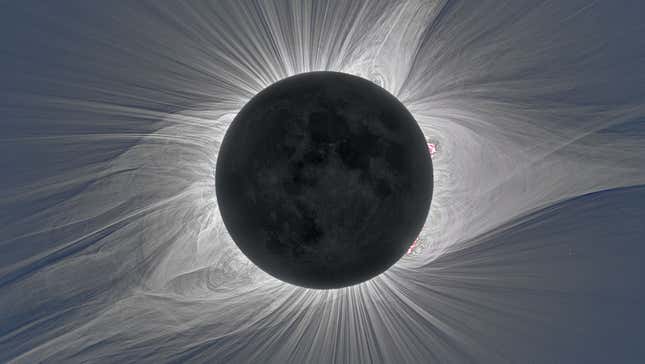
Next month, a total solar eclipse will pass over a slice of the South Pacific, Chile, and Argentina—and directly over an observatory in the Andes run by the National Science Foundation.
Astronomers and physicists are now preparing the experiments they plan to run during the eclipse. As with past eclipses, these experiments will focus on observing the Sun, as well as the effects of eclipses on Earth.
“We’re trying to understand how the Sun shines,” Jay Pasachoff, astronomy professor at Williams College, told Gizmodo.
The telescopes currently at the Cerro Tololo site aren’t equipped to observe the Sun, but researchers can take advantage of the atmosphere of the Andes, as well as the National Science Foundation infrastructure, to set up new telescopes atop the mountain. The NSF’s National Solar Observatory selected five teams who will get to use the site during the eclipse. Researchers will predominantly study the outermost and hottest region of the Sun’s atmosphere, its corona, while one team will study changes to Earth’s atmosphere.
Eclipses are useful tools for solar physicists. Normally, the Sun’s light-producing photosphere far outshines the corona. Imaging the corona requires either specially designed experiments with photosphere-blocking coronagraphs... or the Moon passing directly in front of the Sun.
There are plenty of reasons the corona is interesting. The first, simply, is that there’s a lot that scientists don’t understand about it. We know the Sun goes through 11-year cycles of activity, but there isn’t a good way to predict outbursts of solar activity like solar flares. These blasts of particles can potentially harm power grids and even voting machines or GPS satellites. Pasachoff’s team will image and measure the different wavelengths of light emitted by the Sun, hoping to validate predictions about what the corona should look like.
They’ve also supplied a lens to be flown onboard a plane flying through the shadow cast by the eclipse to make measurements, observing how the corona changes over time, Pasachoff said. A Japanese team led by Yoichiro Hanaoka at the Solar Science Observatory of National Astronomical Observatory will also measure the corona’s change over time, with the help of citizen scientists who will be observing the eclipse along its South American path.
Presumably, other stars have coronas with cyclical behavior as well, and the Sun allows us to study the behavior of a star up close, Pasachoff said.
Studying the magnetic field could also help us better understand solar outbursts, explained University Corporation for Atmospheric Research researcher Paul Bryans. Researchers can measure the magnetic field by measuring the polarization, or the orientation of the light waves relative to the direction they’re traveling. They’re specifically interested in one wavelength of light emitted by certain silicon ions in the corona, and hope it will be a useful solar feature to study with an upcoming solar physics experiment called the Daniel K. Inouye Solar Telescope, or DKIST.
They’re also testing a handheld camera to measure the light’s polarization that might eventually be sent into space so it can measure the Sun without Earth’s atmosphere blocking some of the light, Bryans said.
The eclipse is useful for other reasons. This year, the Sun is close to a minimum in activity—meaning the corona will not look the same as it did during the eclipse of 2017, Shadia Habbal, University of Hawaiʻi scientist who will be leading another project measuring the corona’s changes over time, explained in a release from the Association of Universities for Research in Astronomy.
A final team, led by M. Serra-Ricart from the Institute of Astrophysics of the Canary Islands in Spain, will look at the effects of the eclipse on the ionosphere, the electrically charged outer layer of the Earth’s atmosphere. Intriguingly, the 2017 eclipse seemed to leave a “wake” of waves in the upper atmosphere, one study found, so scientists will want to learn more about that effect and other potential anomalies.
As in 2017, the 2019 eclipse over South America will provide lots of exciting opportunities for solar science. But sadly for those of us in the U.S., it won’t offer viewing opportunities for people in North America, Europe, Asia, or Africa. North Americans will get another shot in 2024.